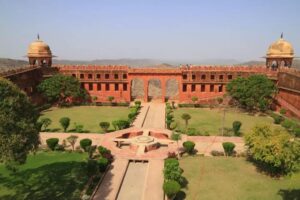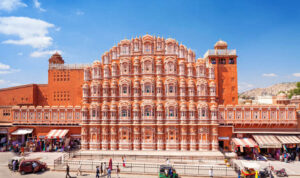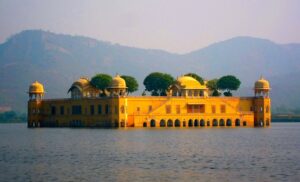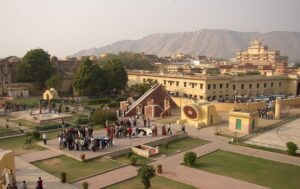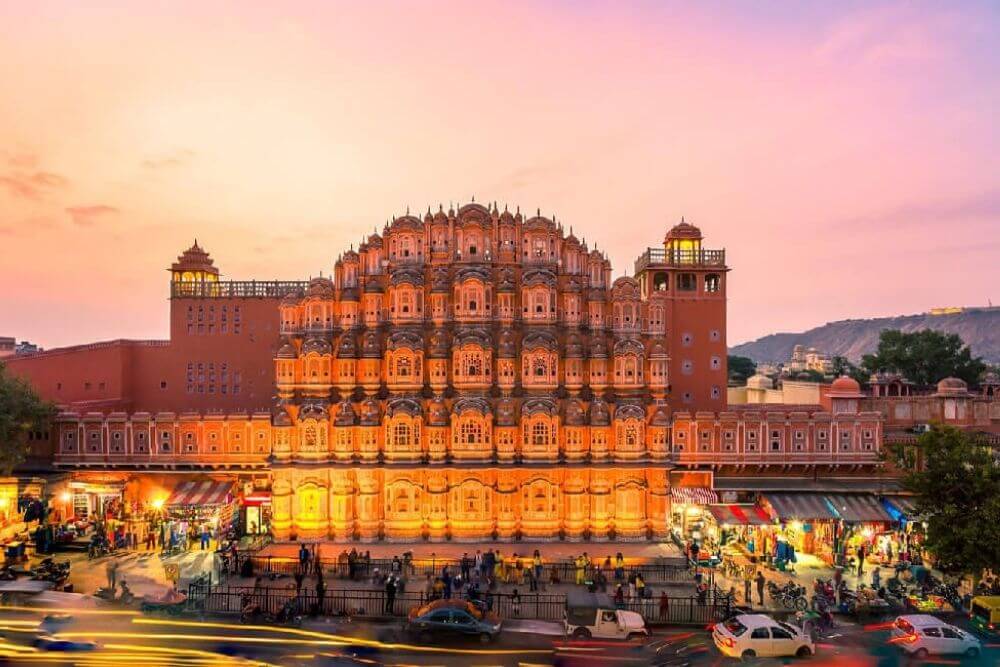
Jaipur
Built by the warrior-astronomer Raja Sawai Jai Singh II in 1727
Jaipur is a charming place, which dazzles the eye of tourists with several architectural landmarks, stylish monuments, palaces, museums, wide avenues, and colorful bazaars. Hilltop forts such as Amber Fort, Jaigarh, and Nahargarh surround Jaipur.
Jaipur is famously referred to as the ‘Pink City’ because Maharaja Man Singh II ordered his city painted a pretty pink in honour of the visiting Prince of Wales, Edward VII in 1876. As with many other places in India, the ancient and the modern co-exist in harmony. In Jaipur, veiled peasant women in swirling ghagras (traditional Rajasthani Skirt) and dazzling odhnis (Stole or Muffler) rub shoulders with youngsters in designer jeans and tie and dye turbans while solemn camels lope alongside shiny cars.
Travel to Jaipur for its many sights and the plethora of shopping opportunities it offers. The old walled area has the City Palace museum, the Jantar Mantar observatory built by Sawai Jai Singh II, temples, gardens, and bazaars chock-a-block with all kinds of goods from exquisite jewellery to dainty jootis (traditional leather slip-on shoes, decorated with colourful embroidery). The Hawa Mahal, with its myriad windows, is a major landmark. The city is best explored on foot. Jaipur is an excellent base from which to explore any popular tourist destination in eastern and central Rajasthan.
History of Jaipur
Jaipur is a city in the northern Indian state of Rajasthan, founded in 1727 by Maharaja Sawai Jai Singh II, the ruler of Amber. The city was built according to Vastu Shastra, an ancient Hindu architectural treatise that dictates the principles of design, layout, measurements, ground preparation, and space arrangement.
Maharaja Jai Singh II commissioned a Bengali architect, Vidyadhar Bhattacharya, to design the city, which was planned on a grid system with wide streets, uniform buildings, and public squares. The city was named after the Maharaja and was intended to be the new capital of the Kachwaha Rajputs, who had previously ruled from the nearby city of Amber.
Jaipur is also known as the “Pink City” due to the distinctive pink color of many of its buildings, which were painted pink in 1876 to welcome the visit of the Prince of Wales (later King Edward VII) and have since remained that way. The city is known for its rich history, culture, and architecture, including the Hawa Mahal, City Palace, Jantar Mantar, and numerous forts and temples. Today, Jaipur is a popular tourist destination and an important commercial and industrial center in Rajasthan.
Best Time to Visit
The ideal time to visit Jaipur is from October to March when the weather is pleasant and suitable for exploring the city’s attractions. During these months, the temperature remains between 10°C to 25°C, making it perfect for sightseeing and outdoor activities.
Places to Visit
Some of the top tourist attractions in Jaipur:
Amber Fort
A magnificent fort situated on a hill overlooking Maota Lake, Amber Fort is one of the most popular tourist attractions in Jaipur. It is known for its stunning architecture and beautiful views.
City Palace
The City Palace is a complex of royal palaces and gardens in the heart of Jaipur. It was built by the Maharaja of Jaipur in the 18th century and is a great place to explore the city’s history and culture.
Hawa Mahal
Known as the “Palace of the Winds,” Hawa Mahal is a stunning five-story palace that was built in 1799. It is a popular spot for photography due to its intricate latticework and unique architectural design.
Jantar Mantar
Jantar Mantar is an astronomical observatory that was built in the early 18th century. It is a UNESCO World Heritage Site and is home to some of the largest stone instruments used for measuring time, predicting eclipses, and tracking stars.
Jaigarh Fort
Another magnificent fort in Jaipur, Jaigarh Fort is famous for its impressive walls, beautiful gardens, and a collection of ancient weapons and artifacts.
Nahargarh Fort
Located on the outskirts of Jaipur, Nahargarh Fort offers breathtaking views of the city and the surrounding countryside. It is a great place to watch the sunset and enjoy a peaceful evening.
Jal Mahal
A beautiful palace situated in the middle of Man Sagar Lake, Jal Mahal is a popular spot for tourists and locals alike. It is known for its stunning architecture and serene surroundings.
Things to Do in Jaipur
Visit Amber Fort
Located on a hilltop, this fort is a must-visit destination in Jaipur. It has impressive architecture and breathtaking views of the surrounding landscape.
Explore the City Palace
The City Palace is a stunning example of Rajasthani architecture and houses several museums, courtyards, and gardens.
Witness the Hawa Mahal
Known as the “Palace of Winds,” this iconic landmark is famous for its unique architecture and intricate latticework.
Visit Jantar Mantar
A UNESCO World Heritage Site, this observatory houses a collection of astronomical instruments.
Stroll around the markets
Jaipur is famous for its vibrant markets, including the Johari Bazaar and the Bapu Bazaar, where you can find everything from jewelry and textiles to spices and handicrafts.
Try local cuisine
Rajasthan’s cuisine is rich and flavorful, and Jaipur has several restaurants that offer traditional dishes like Dal Baati Churma, Laal Maas, and Gatte Ki Sabzi.
Attend cultural performances
Jaipur is home to several cultural events and performances, including the famous Jaipur Literature Festival, which attracts authors and speakers from around the world.
Visit the Jaigarh Fort
Located on a hilltop, this fort offers stunning views of the city and houses several historical artifacts, including the world’s largest cannon.
Take a hot air balloon ride
Experience the beauty of Jaipur from the air with a hot air balloon ride.
Enjoy a camel ride
A camel ride through the Thar Desert is a must-do experience while in Jaipur.
How to Reach
Jaipur is the capital city of the Indian state of Rajasthan and is well-connected by air, road, and rail.
By Air
Jaipur has its own international airport, the Jaipur International Airport, which is located approximately 13 km from the city center. There are regular flights from major cities in India as well as international destinations.
By Rail
Jaipur is well-connected by rail to major cities in India. There are regular trains from Delhi, Mumbai, Kolkata, Chennai, and other major cities to Jaipur. The city has three railway stations – Jaipur Junction, Gandhinagar Jaipur, and Durgapura.
By Road
Jaipur is well-connected by road to major cities in India. The city is connected to Delhi via NH-8, and there are regular buses from Delhi to Jaipur. Rajasthan State Road Transport Corporation (RSRTC) and private operators run buses from other major cities as well.
Once you reach Jaipur, you can use local transport such as taxis, auto-rickshaws, and buses to get around the city.


